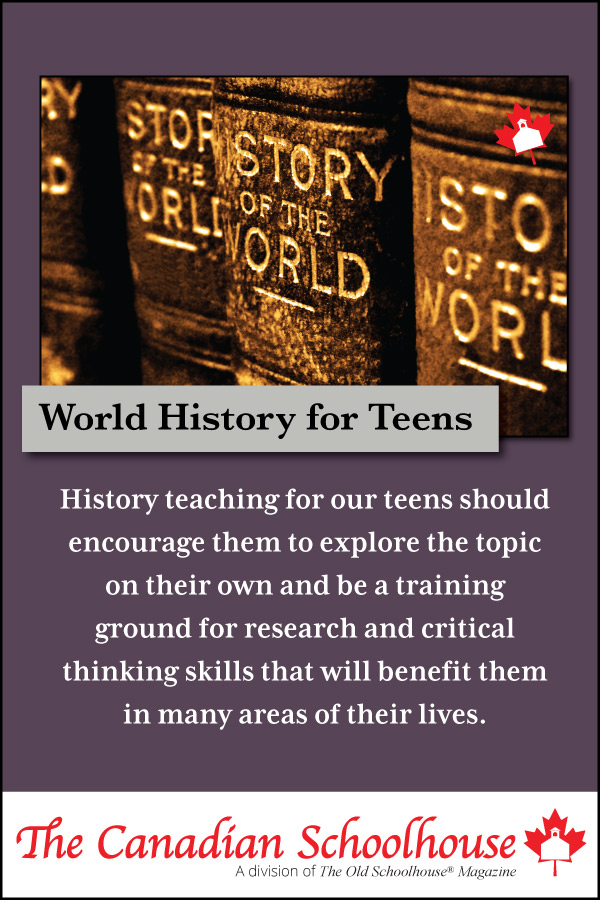
We learn and teach about history for different reasons. Whether our children retain all the facts and can recall the exact dates isn’t as important as the process of learning and that they are able to express their perspectives and opinions on events and eras throughout the ages. History teaching for our teens should encourage them to explore the topic on their own and be a training ground for research and critical thinking skills that will benefit them in many areas of their lives.
The World History course from SchoolhouseTeachers.com takes students on a journey through various resources and guides them to explore different topics further with resources they can discover on their own.
If you're not a SchoolhouseTeachers.com member, you can use this sample lesson as a stand alone teaching that covers the rise of the Ancient Roman Empire. The complete lesson is seen below, but you can get the full lesson through the Course Sample link on the World History about page.
If you are a SchoolhouseTeachers.com member, then you've got access to the whole course, but we hope this short sampling has introduced you to one of our great courses that you may not have found yet.
World History: A Two Thousand Year Tour
Introduction:
This particular high school world history course is different from many others available. It takes advantage of the students’ ability to research and learn as they are digging into history to find the answers to the discussion questions and to formulate their own opinions. Those students who are not accustomed to researching will, hopefully, gain a new skill that will serve them throughout their lives.
Instead of the typical textbook-style course, students will be directed to specific websites, books, videos, and other media during this course. No extra purchase is required. Many resources will be referenced so that students can use what is available to them. Study should not be limited by the resources provided in the lessons, however. Further exploration is highly encouraged! It is my hope that students will be intrigued by the events that have taken place during the last 2,000 years and the fascinating way in which so many events are connected and will desire to further their understanding of history by reading more, watching more, and listening more.
Though we could begin our study at the very beginning of time as we know it, this course will begin with the establishment of the Roman Republic. We simply do not have enough time in a thirty-six week course to cover eight millennia so we will cover slightly more than two. While not every topic will be or can be covered, major events on each continent will be discussed. Some topics will cover more than one week due to their historical importance.
Students should have a globe or a large map of the world to which they can refer. Though many areas of the world have changed drastically over the course of 2,000 years, the geographical position of those areas has remained the same. Historical maps will be provided in the lessons as available.

Week 1: Ancient Rome – Republic to Empire
In Europe, there lies a country said to be shaped like a boot—Italy. Within this country is a city with an extremely rich and fascinating history—Rome. Many things still in use today are a direct result of Rome’s influence in the world many centuries ago. It is with this city we begin our travel through time.
To understand more of the events surrounding the rise and fall of the Roman Republic, see the list of websites, books, and videos to get caught up in the sample lesson.
Questions:
- When did the country of Italy first appear in written records?
- What was the occupation of most residents of Italy at this time?
- What group of people lived in northern Italy at this time?
- What was the political unit adopted by this group? (If you are unable to determine this from the reading, you can click through the link of the name of the group that answers #3.)
- Who were the seven kings of Rome, and when did they rule?
- With what is Ancus Marcius credited? Lucius Tarquinius Priscus? Lucius Tarquinius Superbus?
- What does the name “Superbus” mean?
- When the last king and his family were exiled from Rome, the city already had a senate and an assembly that served the king. These formed the backbone of the republic. What is a republic?
- What were the two main social classes in Rome, not including slaves?
- What was the highest position in government? What did they do?
- How many men ruled as consul at one time? What would be the advantage of this? The disadvantage?
- How did someone become a dictator?
- Who were the lawmakers of Rome?
- What was the Assembly?
- What was the Forum? (The first image in this lesson is a Roman Forum in ruins.)
- Who elected the Consuls?
- Who else did the Assembly elect? What did they do?
- What would be blamed for the fall of the Republic?
- In at least one paragraph, describe the Conflict of the Orders (aka Struggle of the Orders).
Besides the conquest and domination beyond the city walls, Rome began to have internal strife. There were a series of civil wars that aided in the weakening and eventual destruction of the Republic.
Read about the Civil War between Marius and Sulla that took place between 87 and 82 B.C.
Toward the end of the Republic, some new characters come on the scene: a politician—Marcus Licinius Crassus, a statesman and general—Gnaeus Pompeius Magnus (Pompey), a young lawyer—Marcus Tullius Cicero, and a young Senator—Gaius Julius Caesar. Using the following resources, learn about these famous people and the roles they played in the death of the Republic and answer the questions that follow.
Get links for Pompey, Crassus, Cicero, and Caesar from the sample lesson for the next set of questions.
Questions:
- How were Pompey and Sulla connected?
- Describe Pompey’s role in the spread of Rome’s territory.
- What is a praetor? (You may need to refer to a dictionary.)
- What is a triumph?
- What is a quaestor?
- What position did Pompey hold even though he was too young? Who did he share that with?
- What was Julius Caesar able to achieve through his alliance with Crassus and Pompey at the age of 41?
- What did Caesar’s co-consul do? What was the result of that?
- What is the First Triumvirate?
- How do the relationships between those involved in the First Triumvirate disintegrate?
- Detail Julius Caesar’s rise to power.
- What changes did Julius Caesar make while he was dictator?
- What are ideas? When did Caesar die?
- Describe the Julian Calendar.
- Upon the death of Julius Caesar, who rose to power? What happened to the Republic? What did Rome become?
Now, go to: https://www.studenthandouts.com/world-history/ancient-rome/pictures/map-of-the-roman-empire-after-the-death-of-julius-caesar.htm and view the map. This depicts the reaches of the Roman Republic at the time of Caesar’s death in 44 B.C.
Watch: “The History of the Romans: Every Year” from the beginning until 2:48 to see the growth of the territory of Rome during the Republic and the beginning stages of the Empire. (https://www.youtube.com/watch?v=w5zYpWcz1-E)
Journal Entry: What did you find the most interesting about the time of the Roman Republic?
Essay Option: Write a two-page essay describing the events during the time of the Roman Republic, including the main characters. Typically, an essay would be in either Times New Roman or Courier New size 12 font, double spaced. Be sure to include a reference list at the end of your essay. Do not plagiarize! Do not copy and paste but use your own words to describe these events.
See the sample lesson for the remaining content of the lesson titled A Comprehensive World History.
If you’d like to see all that SchoolhouseTeachers.com has to offer your family (one membership price for every member of your family – including access to lots of parent resources!), then go to the membership page for all the pricing options.

























